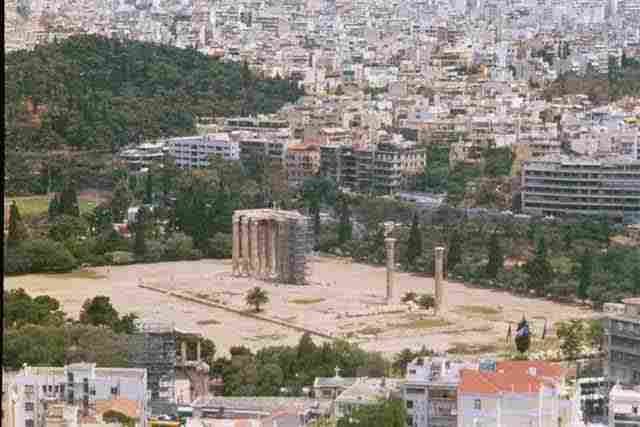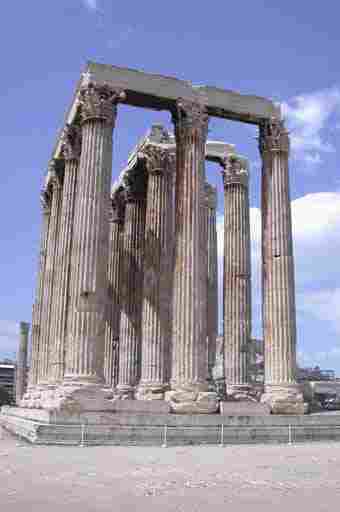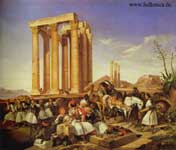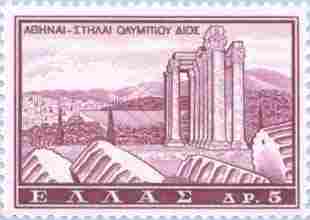.

Temple of Olympian Zeus, Athens [Source]
The Temple of Olympian Zeus, also known as the Olympeion (in Greek Ναός του Ολυμπίου Διός or Naos tou Olimbiou Dios), is an ancient temple, now in ruins, in the centre of Athens. Although begun in the 6th century BC, it was not completed until the reign of the Emperor Hadrian in the 2nd century AD. In the Hellenistic and Roman periods it was the largest temple in Greece.
The temple is located about 500m south-east of the Acropolis, and about 700m south of the centre of modern Athens, Syntagma Square. Its foundations were laid on the site of an earlier temple by the tyrant Pisistratus in 515 BC, but the work was abandoned when Pisistratus's son, Hippias, was overthrown in 510 BC.
During the years of Greek democracy, the temple was left unfinished, apparently because the Greeks of the classical period thought it hubristic to build on such a scale. In the Politics Aristotle cited the temple as an example of how tyrannies engaged the populace in great works for the state and left them no time, energy or means to rebel.
The work was resumed in the 3rd century BC, during the period of Macedonian domination of Greece, under the patronage of the Hellenistic king Antiochus IV of Syria, who hired the Roman architect Cossutius to design the largest temple in the known world. When Antoichus died in 164 BC the work was delayed again.


Temple of the Olympian Zeus (Source, Fr Wikipedia 1, 2)
In 86 BC, after Greek cities were brought under Roman rule, the general Sulla took two columns from the unfinished temple to Rome to adorn the Temple of Jupiter on the Capitoline Hill. These columns influenced the development of the Corinthian style in Rome.
In the 2nd century AD, the temple was taken up again by Hadrian, a great admirer of Greek culture, who finally brought it to completion in 129 (some sources say 131).
The temple was built of marble from Mount Penteli, and measured 96 metres along its sides and 40 metres along its eastern and western faces. It consisted of 104 Corinthian columns, each 17 meters high, of which 48 stood in triple rows under the pediments and 56 in double rows at the sides. Only 15 of these columns remain standing today. A 16th column was blown down during a gale in 1852 and is still lying where it fell.
Hadrian dedicated the temple to Zeus (known to the Romans as Jupiter), the king of the gods. He erected a giant gold and ivory status of Zeus in the cella, and placed an equally large one of himself next to it. Nothing remains of these or anything else from the interior of the temple. It is not known when the building was destroyed but, like many large buildings in Greece, it was probably brought down by an earthquake during the mediaeval period, and the bulk of its ruins taken away for building materials.
The temple was excavated in 1889-1896 by Francis Penrose of the British School in Athens (who also played a leading role in the restoration of the Parthenon), in 1922 by the German archaeologist Gabriel Welter and in the 1960s by Greek archaeologists led by Ioannes Travlos. The temple, along with the surrounding ruins of other ancient structures, is a historical precinct administered by Ephorate of Antiquites of the Greek Interior Ministry. It is open to visitors from Tuesday to Sunday.

Besides these, I do not recollect any one that up to this time has written, though we have formerly produced great architects, and such as were well qualified to have written with elegance. In fact the foundations of the temple of Jupiter Olympius at Athens were prepared by Antistates,Callaeschrus, Antimacides and Porinus, architects employed by Pisistratus, after whose death, on account of the troubles which affected the republic, the work was abandoned. About two hundred years afterwards, king Antiochus, having agreed to supply the money for the work, a Roman citizen, named Cossutius, designed with great skill and taste the cell, the dipteral arrangement of the columns, the cornices, and other ornaments. This work is not only universally esteemed, but is accounted one of the rarest specimens of magnificence.
Another art of the tyrant is to sow quarrels among the citizens; friends should be embroiled with friends, the people with the notables, and the rich with one another. Also he should impoverish his subjects; he thus provides against the maintenance of a guard by the citizen and the people, having to keep hard at work, are prevented from conspiring. The Pyramids of Egypt afford an example of this policy; also the offerings of the family of Cypselus, and the building of the temple of Olympian Zeus by the Peisistratidae, and the great Polycratean monuments at Samos; all these works were alike intended to occupy the people and keep them poor

Zeus Olympios Temple
| Ancient Greece
Science, Technology , Medicine , Warfare, , Biographies , Life , Cities/Places/Maps , Arts , Literature , Philosophy ,Olympics, Mythology , History , Images Medieval Greece / Byzantine Empire Science, Technology, Arts, , Warfare , Literature, Biographies, Icons, History Modern Greece Cities, Islands, Regions, Fauna/Flora ,Biographies , History , Warfare, Science/Technology, Literature, Music , Arts , Film/Actors , Sport , Fashion --- |

